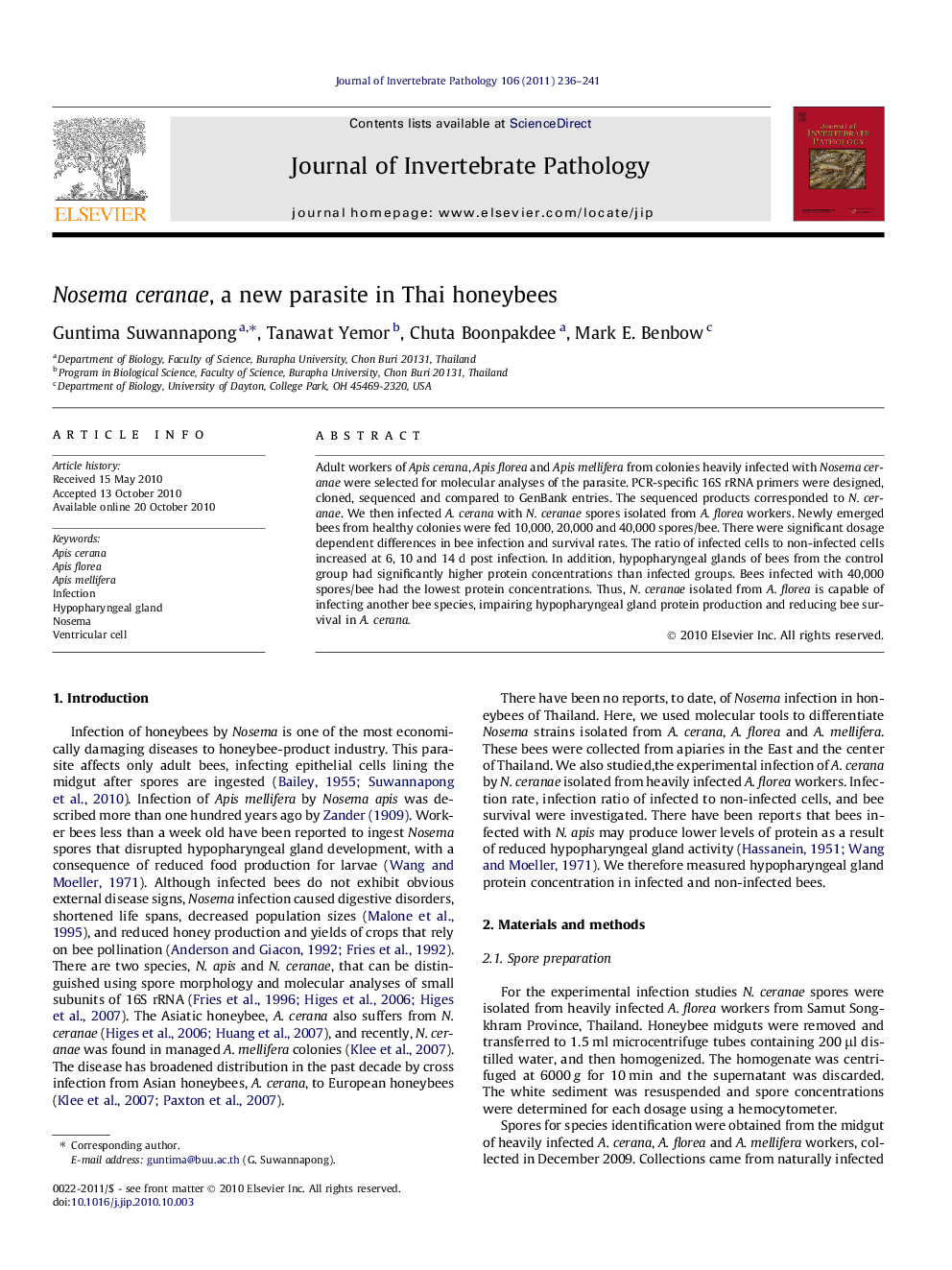| Article ID | Journal | Published Year | Pages | File Type |
|---|---|---|---|---|
| 4558089 | Journal of Invertebrate Pathology | 2011 | 6 Pages |
Adult workers of Apis cerana, Apis florea and Apis mellifera from colonies heavily infected with Nosema ceranae were selected for molecular analyses of the parasite. PCR-specific 16S rRNA primers were designed, cloned, sequenced and compared to GenBank entries. The sequenced products corresponded to N. ceranae. We then infected A. cerana with N. ceranae spores isolated from A. florea workers. Newly emerged bees from healthy colonies were fed 10,000, 20,000 and 40,000 spores/bee. There were significant dosage dependent differences in bee infection and survival rates. The ratio of infected cells to non-infected cells increased at 6, 10 and 14 d post infection. In addition, hypopharyngeal glands of bees from the control group had significantly higher protein concentrations than infected groups. Bees infected with 40,000 spores/bee had the lowest protein concentrations. Thus, N. ceranae isolated from A. florea is capable of infecting another bee species, impairing hypopharyngeal gland protein production and reducing bee survival in A. cerana.
Graphical abstractIn this study a molecular analysis of Nosema ceranae was conducted from specimens isolated from adult workers of Apis cerana, Apis florea and Apis mellifera. In addition, A. cerana workers were experimentally infected with N. ceranae spores that were initially isolated from A. florea workers. For the molecular analyses, PCR specific16S rRNA primers were designed, cloned, sequenced and compared to GenBank entries. The sequenced products corresponded to N. ceranae. For the experimental infection, newly emerged bees from healthy colonies were fed dosages of 10,000, 20,000 and 40,000 N. ceranae spores/bee. There were significant differences in both infection and survival rates among treated bees. The infection ratio of infected cells to non-infected cells at 6, 10 and 14 d post inoculation increased with days following inoculation. In addition, hypopharyngeal glands of bees from the control group had the significantly highest protein concentrations compared to all other treatments, while bees dosed with 40,000 spores/bee showed the lowest protein concentrations. These results indicate that A. cerana infected with N. ceranae spores isolated from A. florea had lower survival rates and reduced protein production of the hypopharyngeal glands. The figure below shows an unrooted consensus tree derived from partial 16S rRNA sequences demonstrating the relationships of Nosema strains tested in this study (N. ceranae from A. cerana, N. ceranae from A. mellifera, N. ceranae from A. florea) (right panel). Light and transmission electron micrographs of A. cerana worker midgut infected with N. ceranae also given (left panel). .Figure optionsDownload full-size imageDownload as PowerPoint slideResearch highlights► This manuscript contains the first report of experimental infections of Apis cerana with 10,000, 20,000 and 40,000 Nosema ceranae spores/bee isolated from Apis florea workers collected from heavily infected-colonies from Samut Songkram province, Thailand. ► A molecular analysis (16sRNA) of Nosema isolated from three Apis species including Apis mellifera, an introduced species to Thailand, and native representatives A. cerana and A. florea. Infection rate, infection ratio between infected and non-infected ventricular cells, survival rate, and protein contents of hypopharyngeal glands were evaluated as responses to infection.
